Djembe Know-How & Drum Maintainance
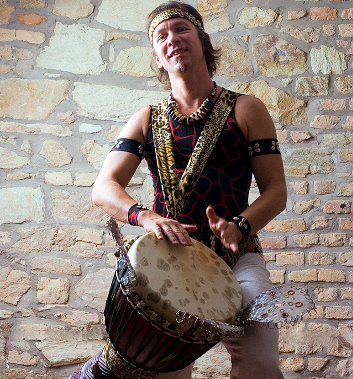
Important knowledge & advice on
- How to play a Djembe
- How to tie a Djembe strap
- Djembe tuning & tightening
- Djembe maintainance
- Djembe reskinning
We want you to enjoy your Djembe drum and have a liftime of pleasure with it. On this page we have put together the most important informations about Djembe drumming. Unfortunately some of the advice that can be found on the internet is not correct. If you inform yourself ectensively you will have more pleasure with your musical instrument. We hope that we can support you with our know-how. A comprehensive knowledge encyclopedia on Djembe drums and djembe related topics can be found on our German Djembe-forum.com
How do you play a Djembe drum?
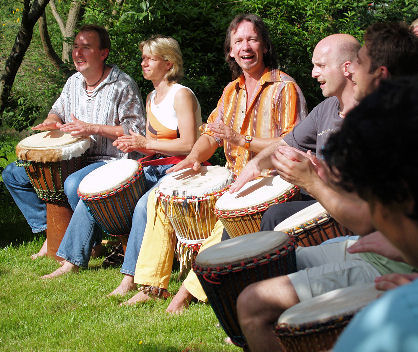
Every skill has more to it than simply technique. It needs a special mental state of mind that springs from an inner peace. A Djembe drum is not just a piece of wood that you beat. It is more than that. It is like a partner able to convey your feelings and aim to make them heard. The requirements to master these sounds are the love for percussion music and the strong will to learn about your drum as well as the sensitivety and patience to watch and listen carefully. Use your senses when you play. There are three basic sounds that you need to create rhythm and melody. These are: The bass, the tone and the slap.

The Bass
is played with the full hand in the center of the drumhead. Allow it to bounce off immediately. It evokes a warm and deep, longlasting resonant sound.
The Tone
is played with flat hand and the fingers together lightly contacting the rim with the junktion of fingers and palm. You create a full warm and short sound.
The Slap
is played with spread fingers, giving the drumhead a short slaping impulse with a flexible wrist. This creates a high pitched sound.Video ➽ Djembe playing techniques: Bass
Video ➽ Djembe playing techniques: Tone
Video ➽ Djembe playing techniques: Slap
Video ➽ Djembe playing techniques: Bass, Tone & Slap
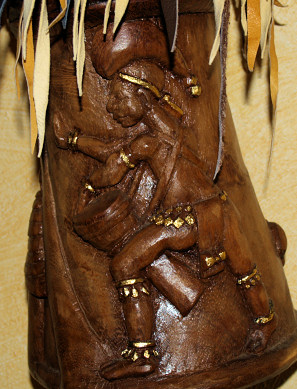
How do you tie a Djembe strap?
In order to play your Djembe drum while standing you need a 4 m long strap. This strap is fastened on the upper ring of the Djembe and around the foot. It can, for example, be passed through a woven handle attached to your drumhead, or threaded through the vertical ropes. Connect both ends with a knot to obtain an endless belt. This is then placed around the neck of the Djembe foot. Lay your Djembe on the floor, the playing surface facing away from you, the foot is between your legs. The center of the strap is lead underneath the neck of the Djembe. Now you cross the two sides of your strap, insert your head through the middle and your arms through the left and the right space. If you stand up the strap should be on both shoulders and crossed over on your back, running around your hips and underneath the neck of the Djembe. The length of the belt should be set so that you can play relaxed with slightly angled arms.
Video ➽ Djembe Strap1 & Strap2 , how to tie and wear it
Video ➽ Bogolan & Cotton Djembe Strap tying and wearing
Djembe retightening & retuning

The following manual is also useful for tuning Bougarabou, African Bassdrums and other drums that use the same rope-system. The speciality of a Djembe drum is its wide tonal range and the possibility to differentiate between a deep Bass and medium high Tone and a very high pitched Slap sound. The basic requirement for this tonal range is a very high drumhead tension. Every drum should be well prepared with a relatively high tension of the vertical ropes. For retightening and tuning one uses the reserv rope that is often tied arround the neck of the Djembe. You have to undo the reserve cordage an weave it in to the exesting vertical ropes in a horizontal line to broduce a specific system of knots. Thes knots bring a extra tension on to your drumhead by pulling down the iron rings a few millimeters. THe tensioning knots can be woven any direction, to the right or to the left as shown here. There are several tecnniques for retensioning. We show you the two most popular ones here.
System A
With system A you pull the horizontal rope underneath the next two
verticals, than back over the second vertical line and underneat the
first one. If you pull strongly they will cross as shown here.
System B
With system B you lead the horizontal rope above the next two
vertical cordages , than underneath the second and above the first. If
you pull strongly they will cross as shown.

To perform both systems you lay the drumn on the ground infront of you with the drumhead facing away from you. Pull the reserve rope towards your belly to cross the knots.
Repeat the knots untill you get the needed tension, but be carefull not to overstretch it because a drumhead can tear . If you have a well prepared Djembe you usually need 3 - 4 Knots only if you have a prestretched cordage.
For finetuning and in order to ensure that the tension is evenly distributed you can tap on to each knot of the upper clamping ring with a wooden hammer. But pleasse be very carefull not to touch the skin, becauls it can break.
The photo below shows the tesioning knot with system A in four steps.

Video 1 & 2 ➽ Djembe Rope Tuning
These videos show the professional Djembe tensioning process. Gavin was filmed over his shoulder so that you can easily copy the knotting system. The first Video is in german language. As an english speaker you can see all important details in the pictures and understand what is most important even without speaking german. ;-) In the first video Gavin explains the important relationships and basic quality requirements, materials used, the right tools and how to use them. If you are not sure if your Djembe drum is made of such stable components as ours, and how many new knots your Djembe can tolerate when re-tensioning, please first carefully approach the tuning of your Djembe drum with only one or two knots quite sensitively and tenderly. Never ever hit the drumhead skin with the hammer! Just tap the knots carefully to lower the ring down evenly before and after tightening. The second video is kept without words, so that you can concentrate on the essentials. In this video Gavin also shows how to knot the transition to the second row. It is intended for those who already have some basic knowledge about Djembe tuning, have seen it at least once and would like to refresh their knowledge on how to tune a Djembe.
Djembe drum maintainace
Most importent is a mindful handling. For us drums are like friends. We love them and respect them. Especially wen transporting a drum a well made bag or case is important for protection. Especially the skin is sensitive.
Wood and skin react to climate changes, especally humidity. Our drum timbers a well dryed and then protected with Karitébutter and our own fine oil. Generally this protection lasts for many years. If dry places do occur on the wood you can oil it carefully.
Gernerally one should not oil the skin because it can get stains, loose its tension or even get greasy. Every person has a certain ammount of fat on his hands and this also trasferes to the drumskin while playing. Normally this is enough to keep it from drying out.
Be aware that there are the wildest theorys about this toppic on the internet. Not every so called expert is really one :-)
Drumhead Reskinning
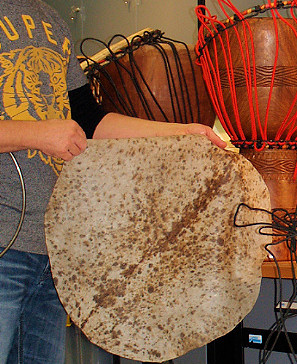 If
you want to reskin your Djembe, Bougarabou or any other African drum you
need a raw skin that has been evenly and cleanly prepared. Compare Goatskins & Cowskins. Besides the timber and
the shaping of your drum the strength of your drumhead skin influences
the sound very much.
If
you want to reskin your Djembe, Bougarabou or any other African drum you
need a raw skin that has been evenly and cleanly prepared. Compare Goatskins & Cowskins. Besides the timber and
the shaping of your drum the strength of your drumhead skin influences
the sound very much. In preparance you should soak the dry skin in water for 3-6 hours until it becomes soft, smoth and flexible. The stronger the skin is the longer it has to soak. We prefer soft rain water. Using warm water can speed up the soaking process. If you soak the skin too long than anaerobic bacteria will start decomposing the protein structures. The result is a strong smell developing the remind of dead animals. If you have a very fatty skin unperfumed natural soap can be added to the water. This will also improve the smell especially if using mail goatskins. Brush out all remnants of soil dust and dirt under running water and rinse it thorougly with lots of fresh water.
Let the wet skin drip off and position it on the rim so that the spinal line runs right across the centre of the drumhead. This provides that natural differences in thickness are evenly distributed. Generally the outside of the skin should face upwards. Fix your skin position by laying the first ring over your shell. Fold the overhanging sides (you need aprox. 10 cm on each side)
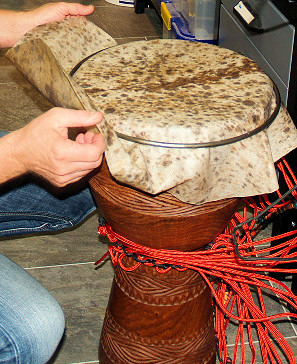 back to the middle and set the second ring with the knots exactly
matching on top. Enshure that the ring level has the same hight to the
rim and the same distance to the shell on all sides.
back to the middle and set the second ring with the knots exactly
matching on top. Enshure that the ring level has the same hight to the
rim and the same distance to the shell on all sides. Now tighten the rope very evenly all around the drum. An even tension will result in a more harmonious sound. While your skin is still wet don't overstretch it and better only use your hands for the first tightening. If you don't have a preshaved skin it is best to shave it with a razor blade while it is still moist. Hold the razor blade between your thumb and two fingers and scrape in the direction of the hairgrowth. Be very careful not to move the blade sideways because this could easily cut through your skin. You can shorten the overlap 2 cm obove the upper ring or let it hang over the rings and tie it back in any prefered shape. During the drying process the skin will adapt to the new shape.
Only after several days of intense drying it is recomended to tighten the skin and give it the typicall high tension that is neede to difeentiate the sounds. We recomend you to place your drum in a warm and dry room for aproximately 7 days before you tension it ready to play.
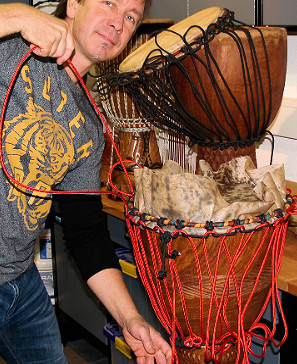 You can use a simple stick for tightening like in Africa or real tools
like the 'CLAMCLEAT Power Grip' or our professionel lever. See Ropes, Rings & Tools. If you want to prevent
each line of cord slipping back during your work use our Locking Pliers.
You can use a simple stick for tightening like in Africa or real tools
like the 'CLAMCLEAT Power Grip' or our professionel lever. See Ropes, Rings & Tools. If you want to prevent
each line of cord slipping back during your work use our Locking Pliers.
Finally you can smoothen the drumhead surface carefully with very fine sandpaper in 240- 320 K and repeat tightening after 2-3 days. We wish you lots of success.


